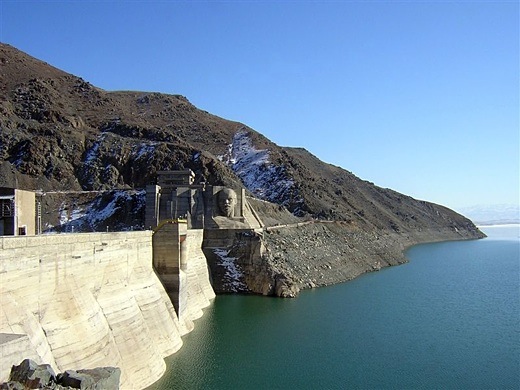As if electricity blackouts weren’t bad enough, now residents in rural Kyrgyzstan are having difficulties accessing water. Without electricity, Kyrgyzstan’s new water pumping system is inoperable; and some pumps have been damaged by the irregular supply of power.
 image above: Soviet era dam built to provide water and electricity in Kyrgystan.
From http://www.rferl.org/content/article/1070815.html
image above: Soviet era dam built to provide water and electricity in Kyrgystan.
From http://www.rferl.org/content/article/1070815.html
"The energy crisis and the drinking water supply have a direct connection. If there is no electricity, in most cases it means there is no water," Talant Ormushev, head of production at the Department of Rural Water Supply, told www.EurasiaNet.org.
According to Ormushev, the majority of Kyrgyzstan’s villages receive water supplied by water towers that, in turn, depend on electricity to fill their tanks. But electricity supplies are sporadic, with some villages reportedly receiving only five hours of power per day.
Over the past seven years, the Kyrgyz government has spent almost $70 million to build or rehabilitate rural drinking water supply systems in 509 villages. Known as Taza Suu ("clean water"), the project was designed to replace old Soviet technologies with modern, electrified pumps and cleaning stations. At the same time, the Kyrgyz government transferred management of rural drinking water supply systems to local organizations known as public unions. These unions took on responsibility for maintaining the system and fund themselves by charging small fees for water.
But all is not going to plan.
"The water pumps are not supposed to work in this emergency situation. Technologically they must work constantly. Every time you switch off and then switch on the electricity, they come under pressure. It results in early deterioration and breakage," said Turdukul Ishenbaev, the Department of Rural Water Supply’s representative in the Alamedin region.
Ishenbaev explained the increasing burden the burnt-out pumps are having on consumers. Villages collectively scrape together the repair fees. "To change a broken pump machine ... costs around 60 thousand som ($1,500). Every household must collect 100-200 som (up to $5). It’s a big financial burden for villagers."
"In Tash-Tobo [a village outside of Bishkek], three out of four water pumps broke down this month. The villagers agreed to pay for the repair the first time. But they are not going to pay if it breaks again. Instead they promised radical actions. I also know several public unions are going to bring action against [the state-controlled] electricity company," Ishenbaev recounted.
"This is going on all around the country," he added.
Indeed, a pump repairman for the private company, Shaturnyi - which provides repair service to water pumps - confirmed the rise in breakdowns. "We have three or five, even six or seven requests daily, which is a lot. I think in spring it will be even more," he predicted.
The water problems are causing some to take to the street. Ekaterina Nepomnyashaya, a lawyer for the Public Association for the Social Protection of the Population, an NGO, says complaints are increasing.
"Before, people in Bishkek and around complained to us only about electricity blackouts. Then we noticed a shift. People started to complain about drinking water shortages because of the energy crisis, especially in rural areas," she told EurasiaNet.
On November 24, around 1,500 villagers from Leninskoe protested against the blackouts and related water shortages. For two hours, villagers and police struggled for control of the Bishkek-Almaty highway. "There is no electricity and there is no water. You can’t cook, wash your face or your clothes. The absence of water is even worse than electricity," said one protester.
Anara Choitonbaeva, head of Kyrgyz Water and Sanitation Alliance, an NGO, says the problems accessing water may be having hidden consequences for public health.
"Rotating blackouts influence drinking water quality in many ways. First, bactericidal lamps and chlorine drips to disinfect water work electrically," she explained. "Second, to change or repair water pumps takes several days. After 24 hours, pathogens grow in the standing water inside the pipes, filters don’t work properly and sand and dirt mixes with water. Silt-up is occurring."
But Nina Vashneva of the Health Ministry’s Sanitation Department insists that there is no reason for concern. "I don’t see any connection between water quality and electricity blackouts. If something happened we would prohibit using water. Until now nothing has happened," she told EurasiaNet.
Ironically, areas where the Taza Suu project has been completed are now more vulnerable to disruptions, having sold or dismantled their old means for distributing water. "Before the new [Taza Suu] pipe, we took water from the river and used donkeys to transport jugs. Then we sold [the donkeys and the jugs]. Now there is no water again, and we don’t even have [tanks] to store the water," said a villager in Issuk-Kul oblast.
"You can survive the absence of electricity, but it’s not possible for a human being to live without water. Psychologically, the combination of electricity and water absence is very stressful. Obviously it increases social tensions in society," explained Choitonbaeva.
see also: Ea O Ka Aina: Kauai Water Security 10/10/09
2 comments :
the water shortages is a big problem that we are facing now. I am agree with this blog because without water we can have energy and no other thing.
wowwwwwwwwwwwwwww
Post a Comment